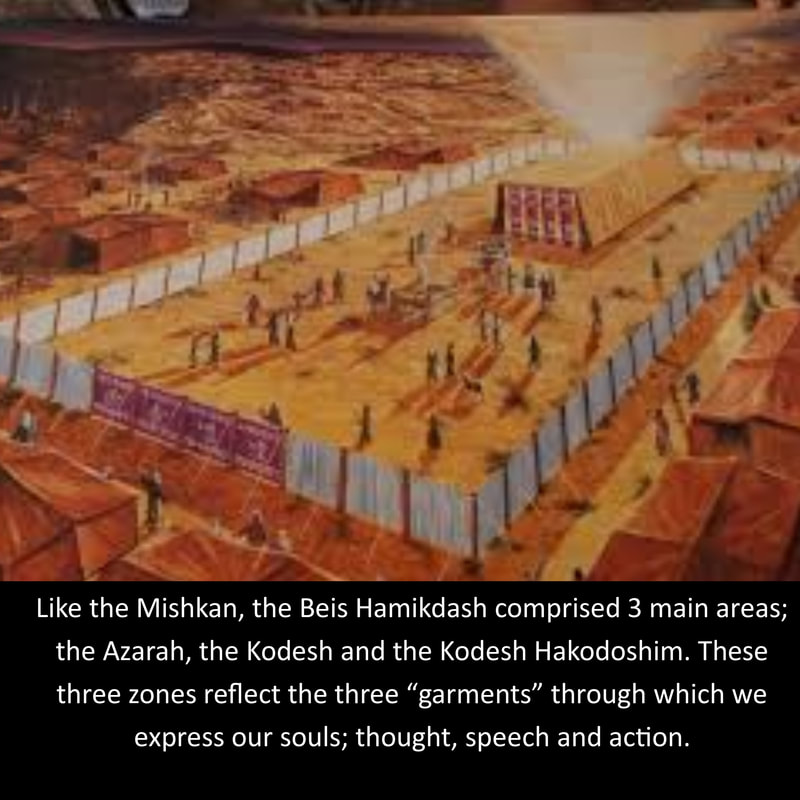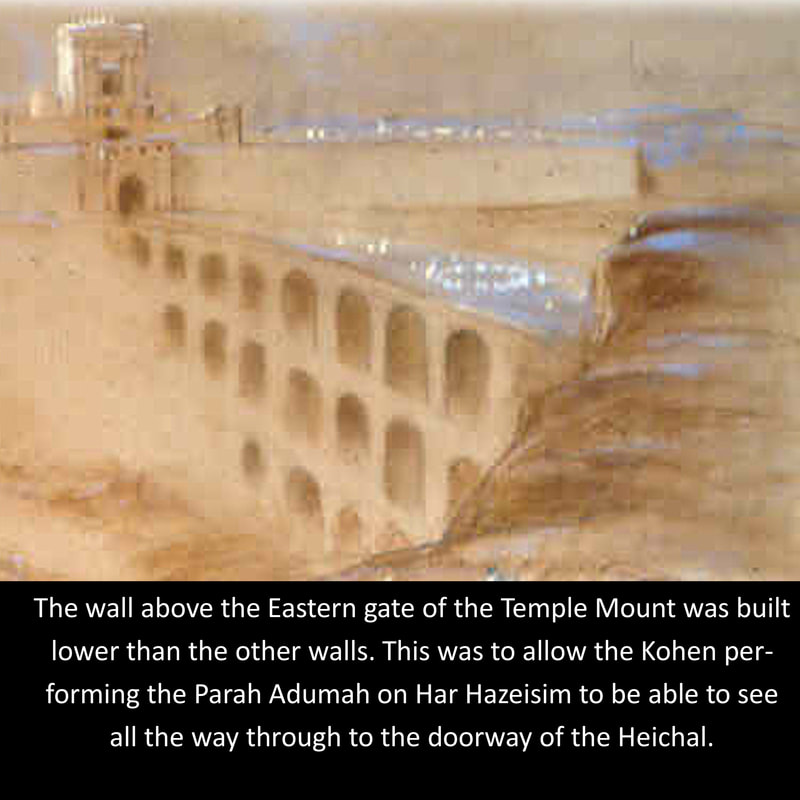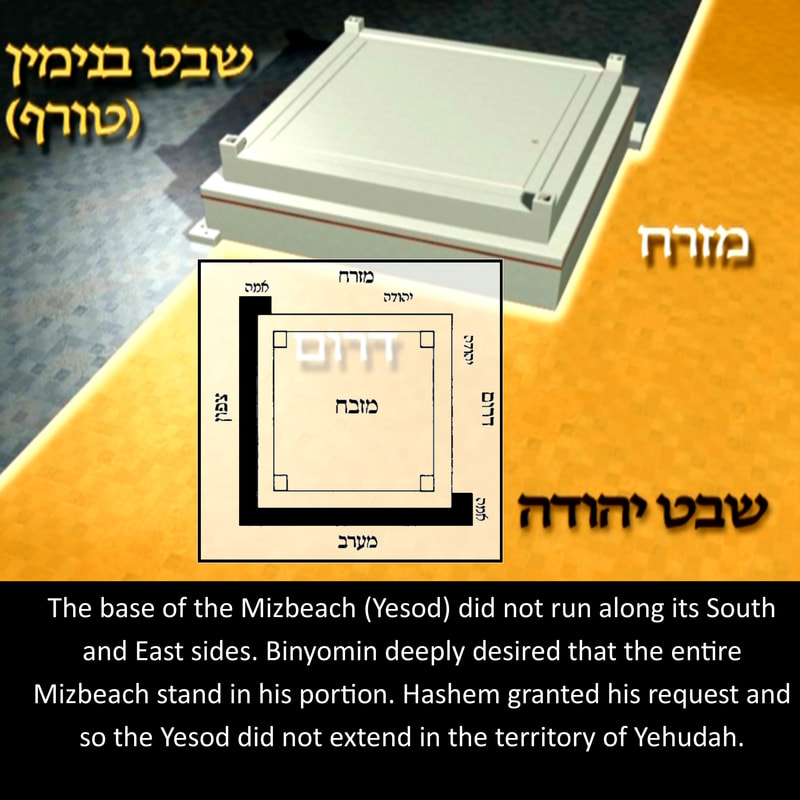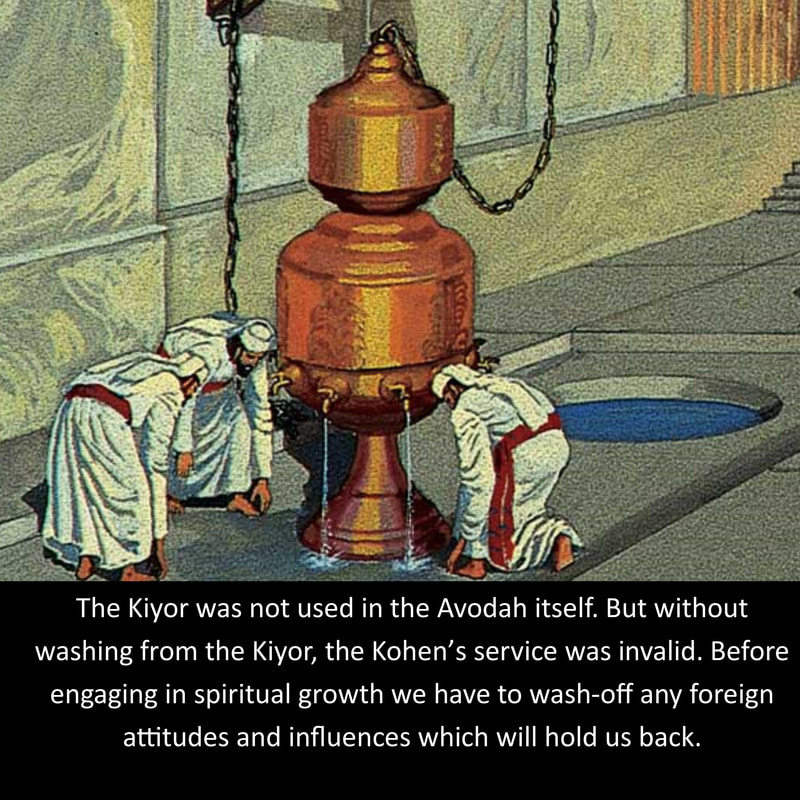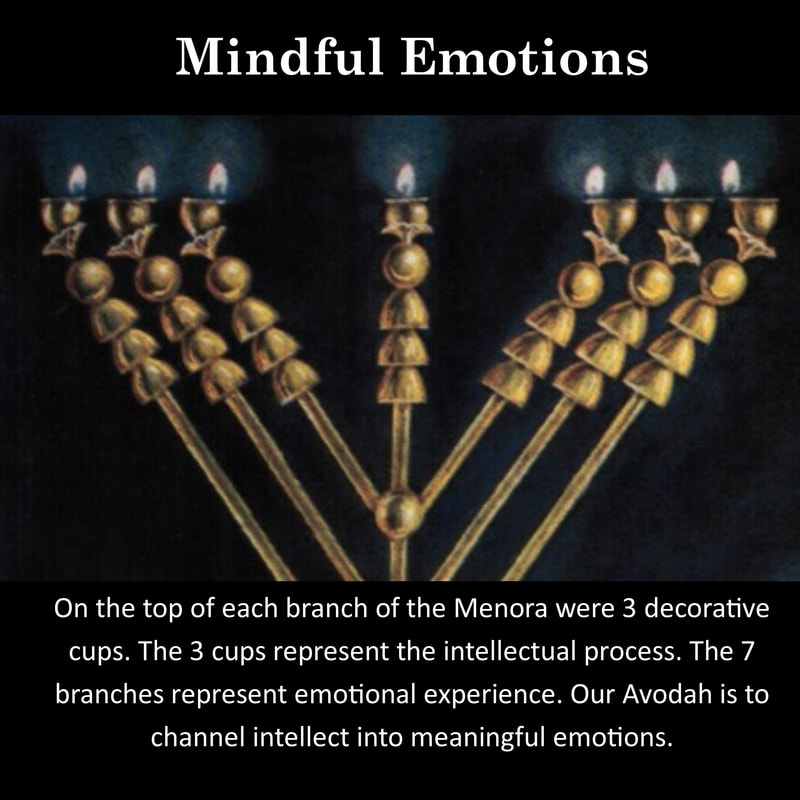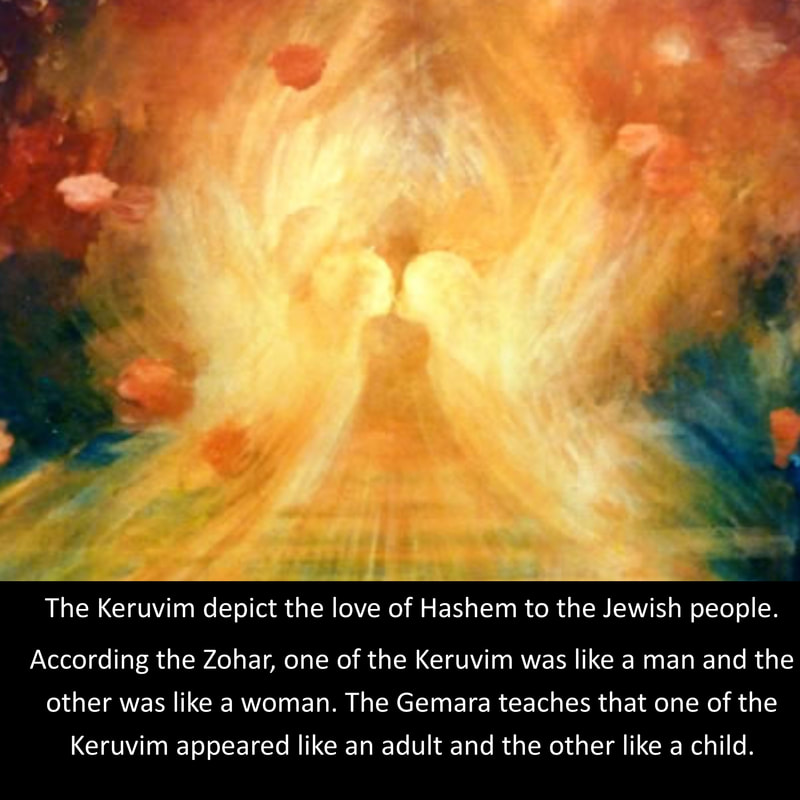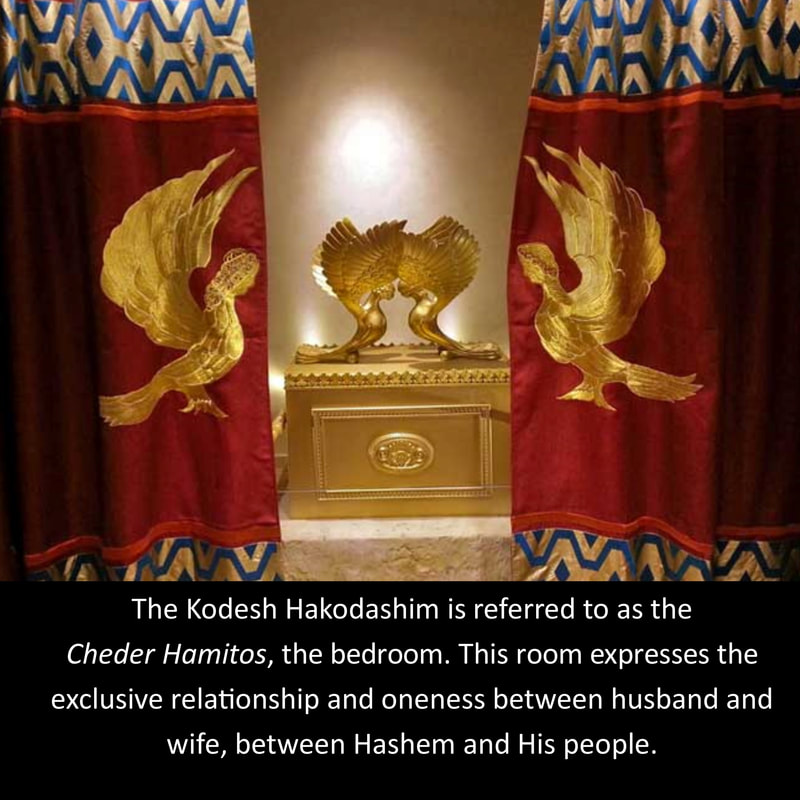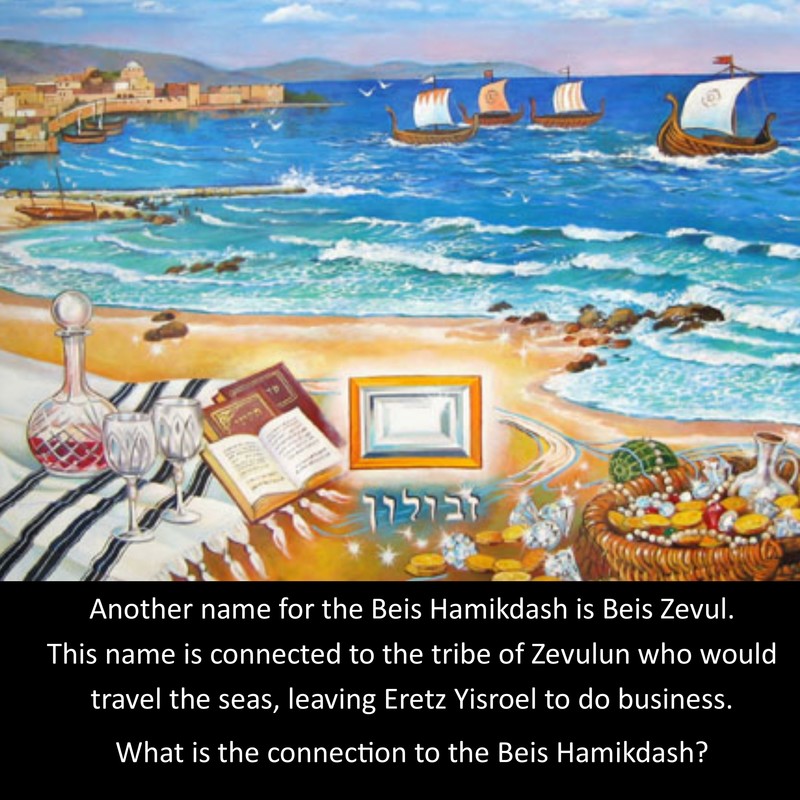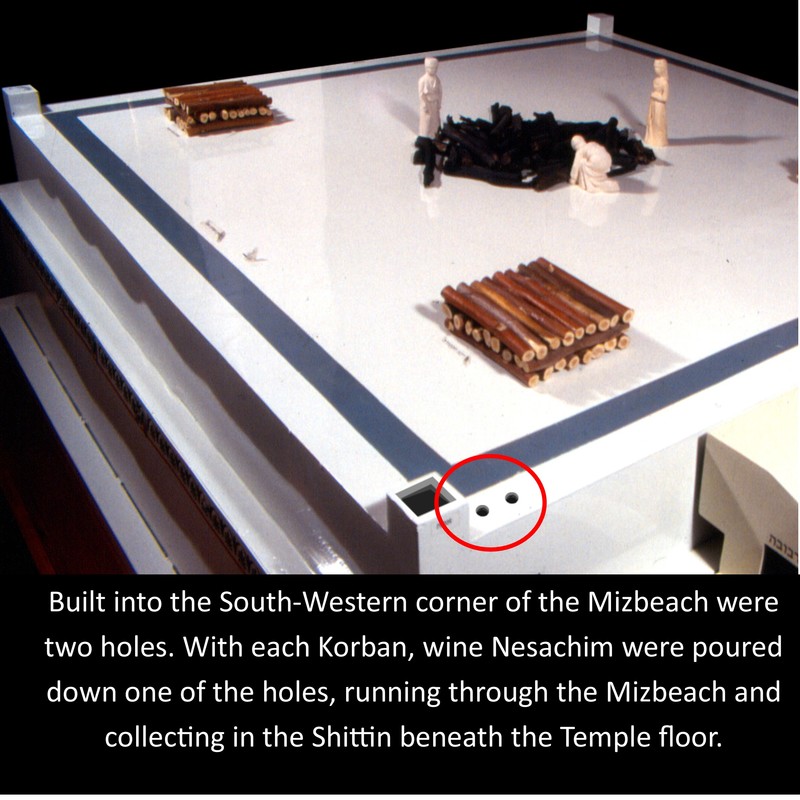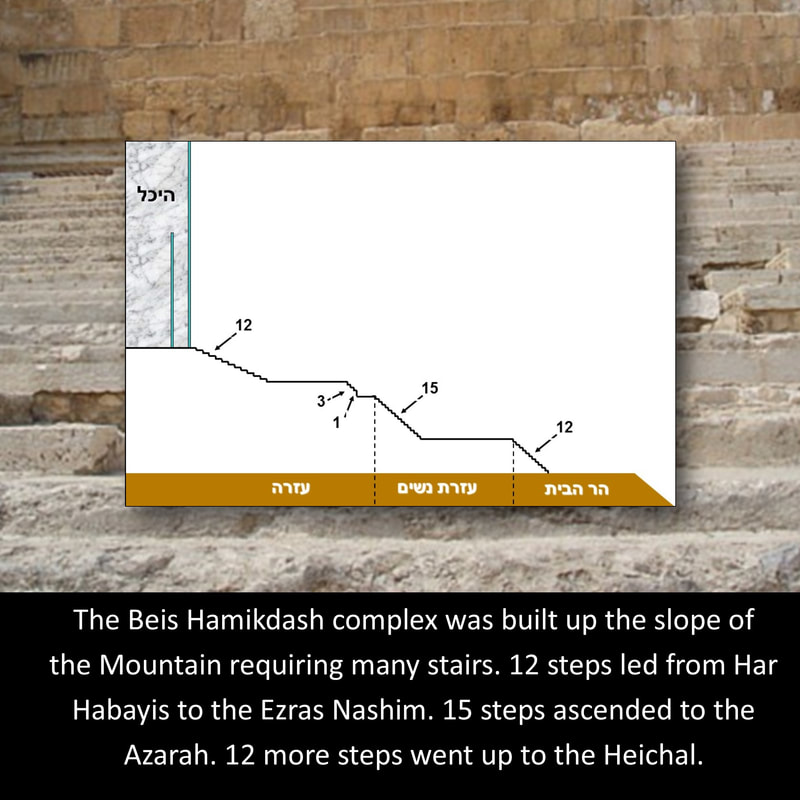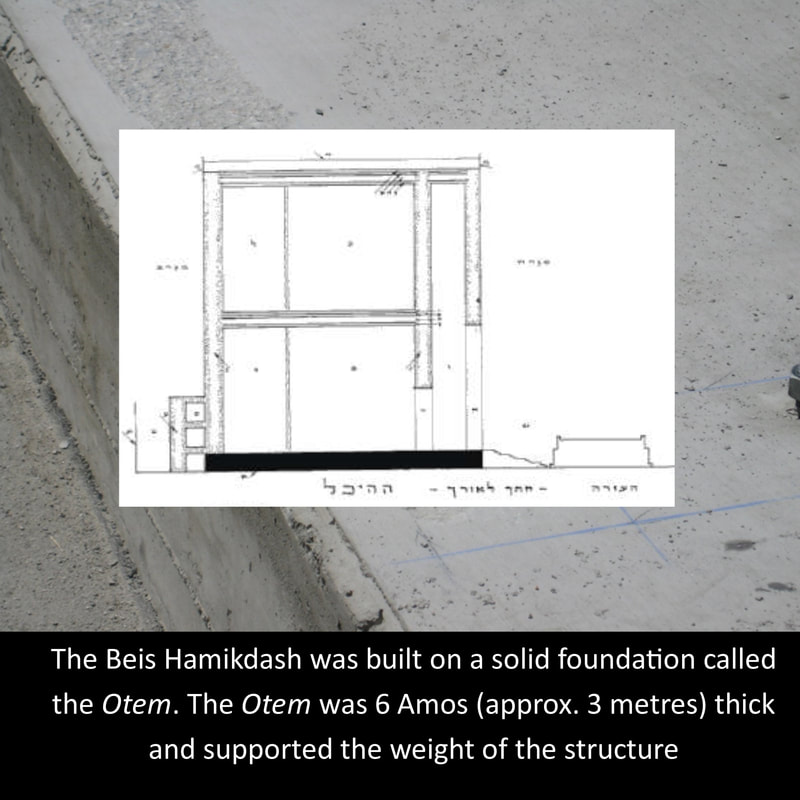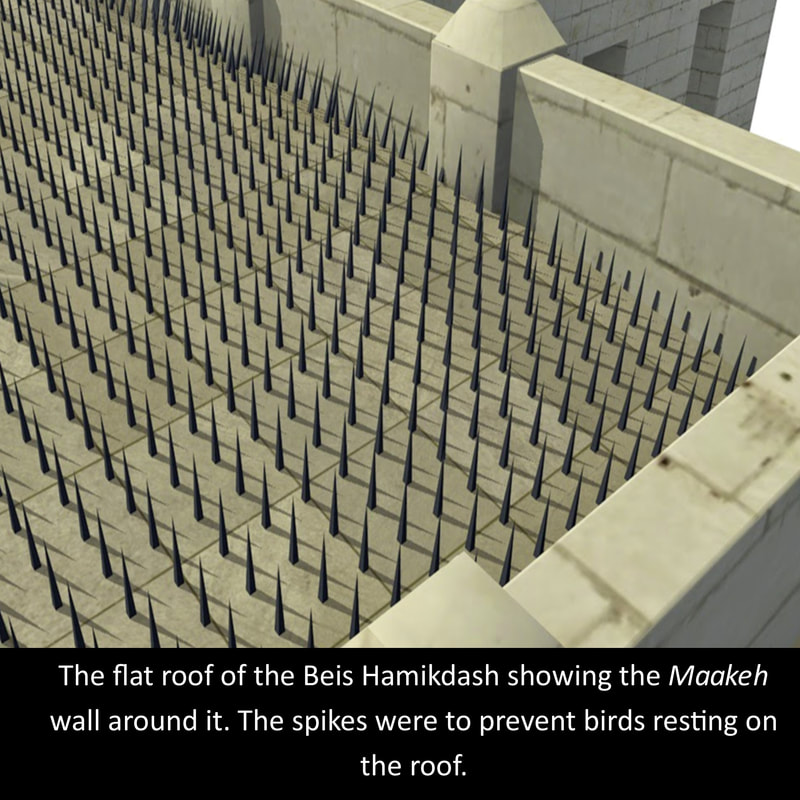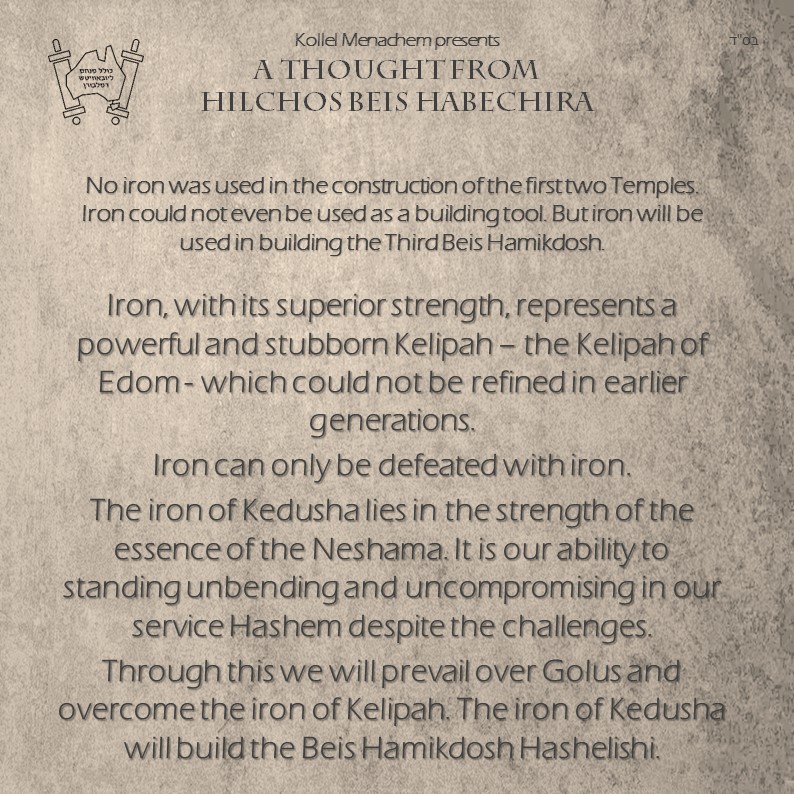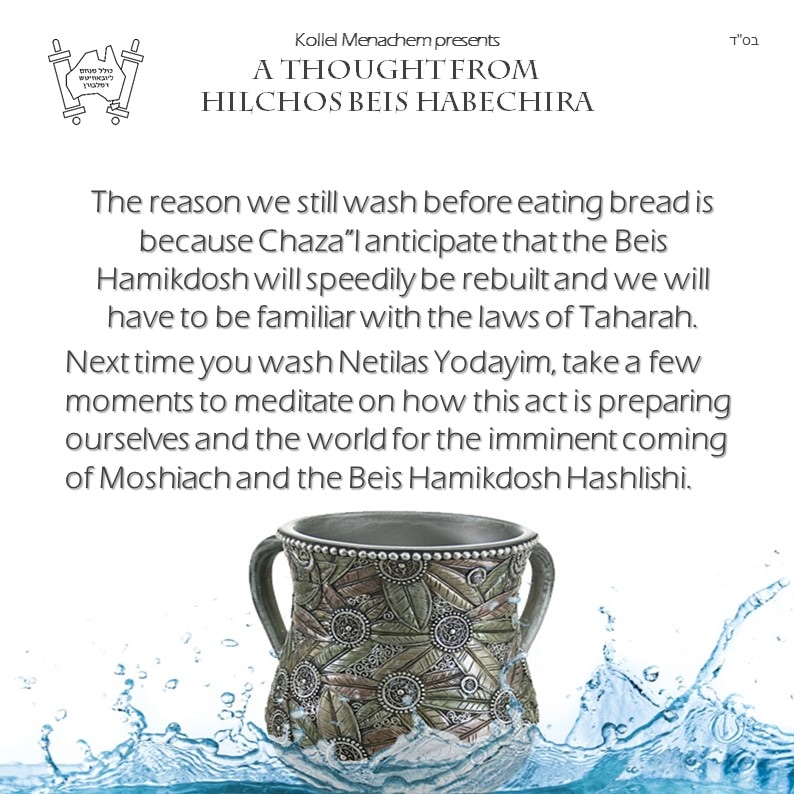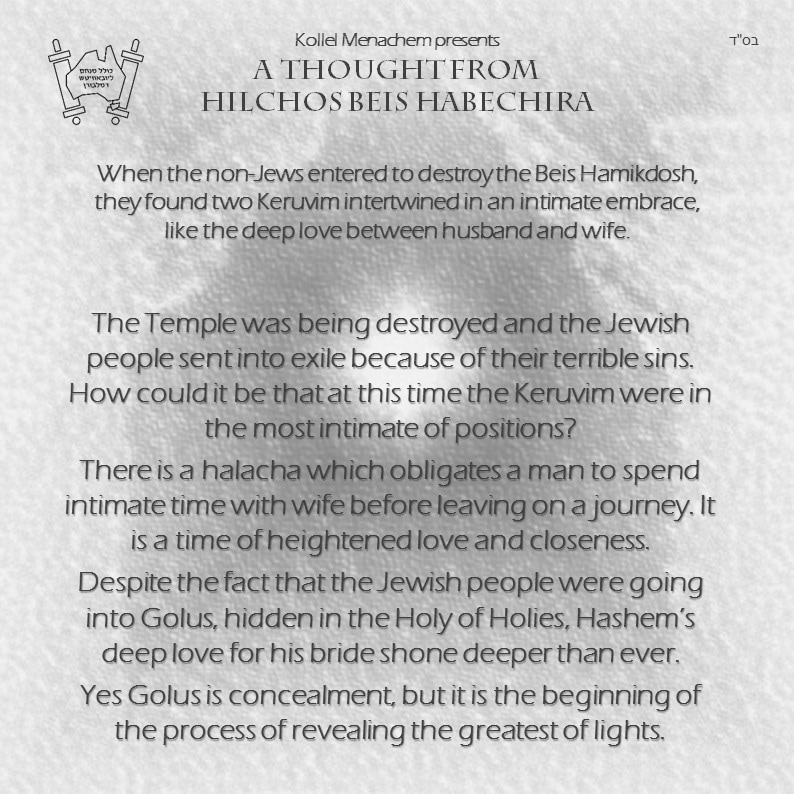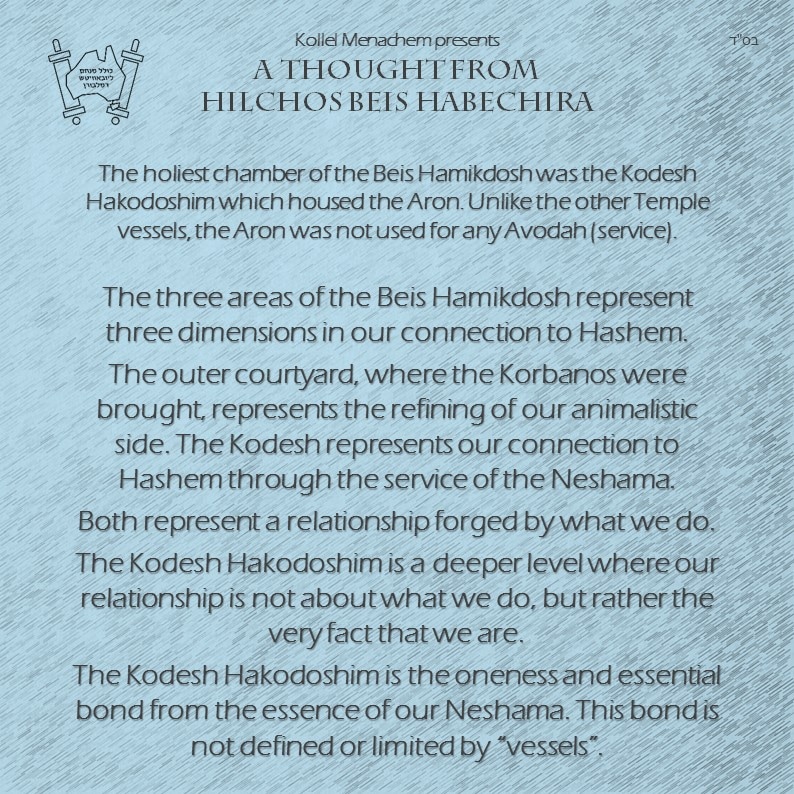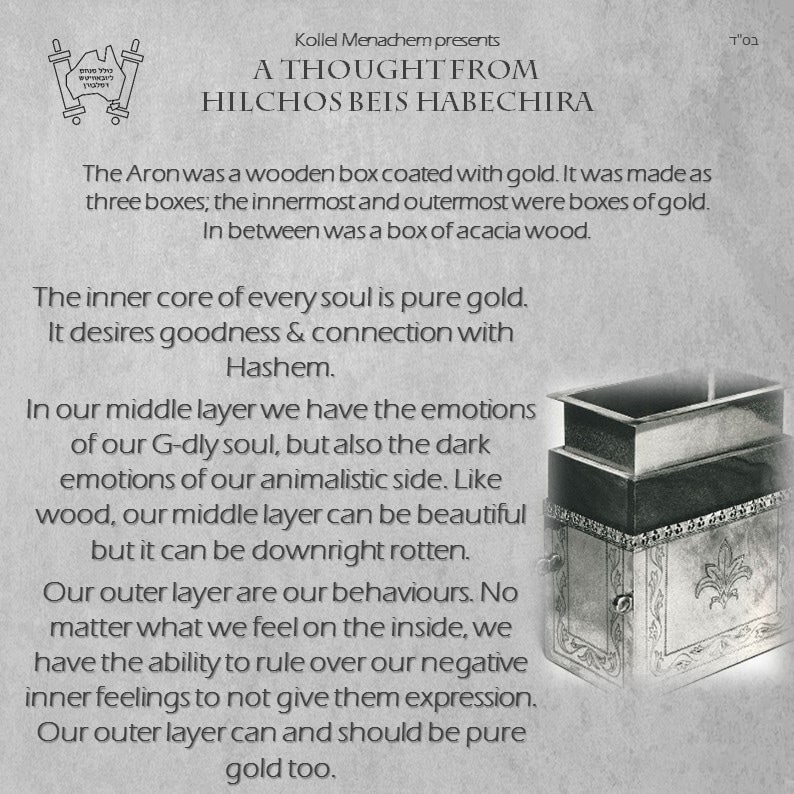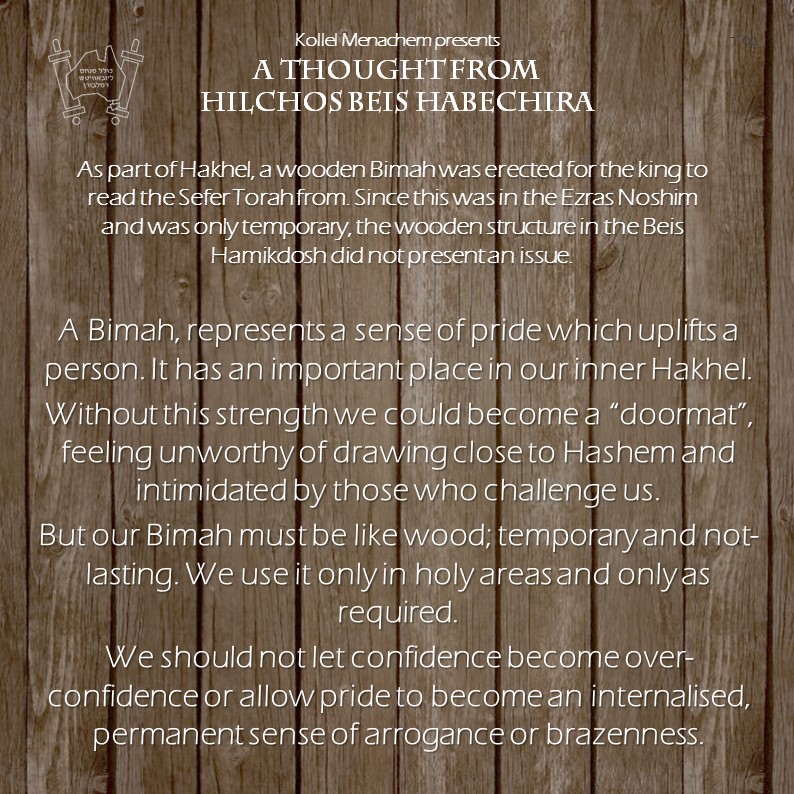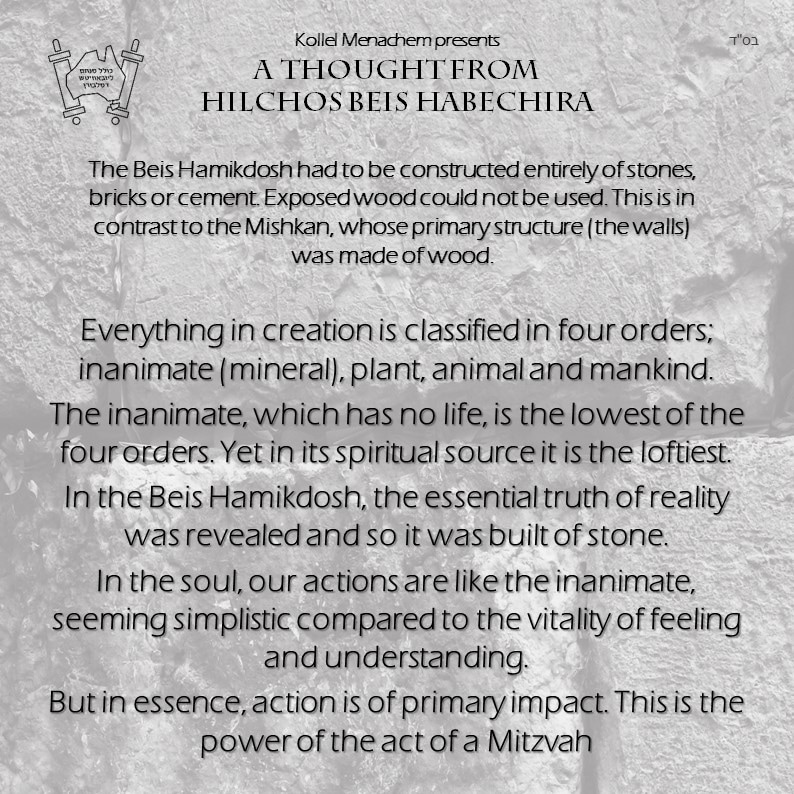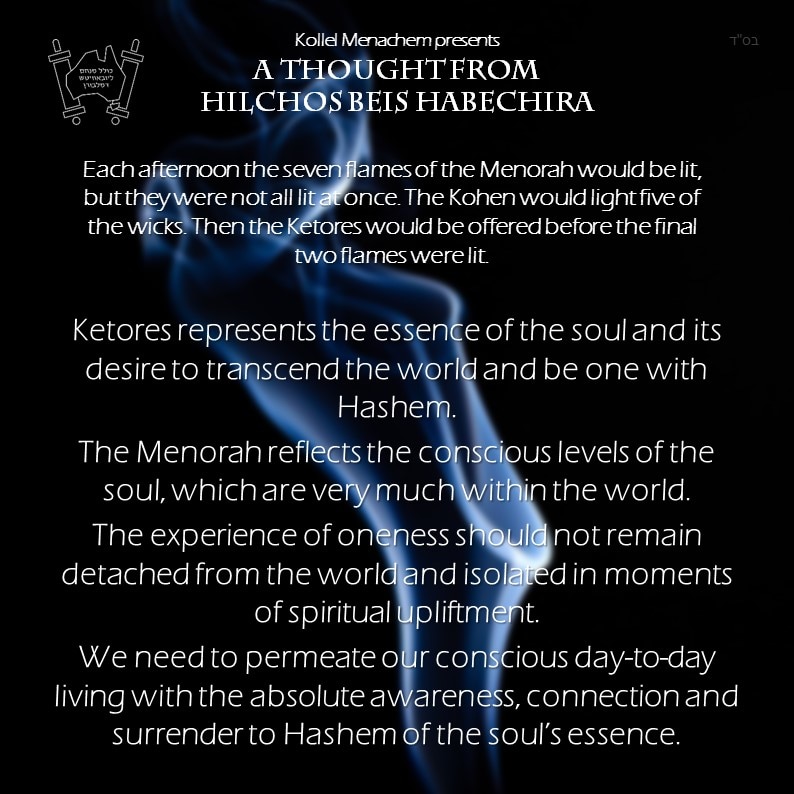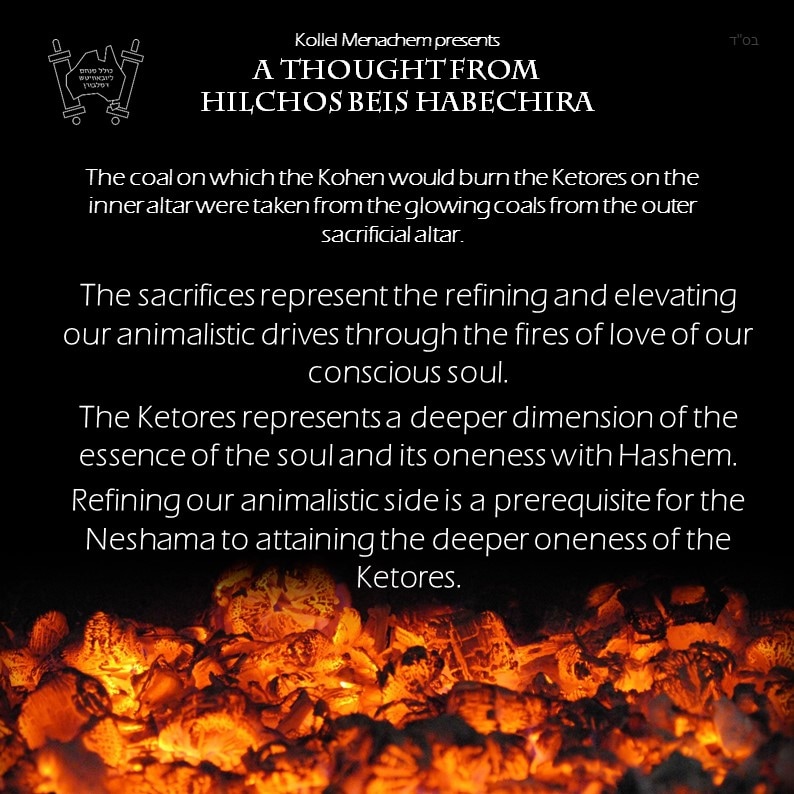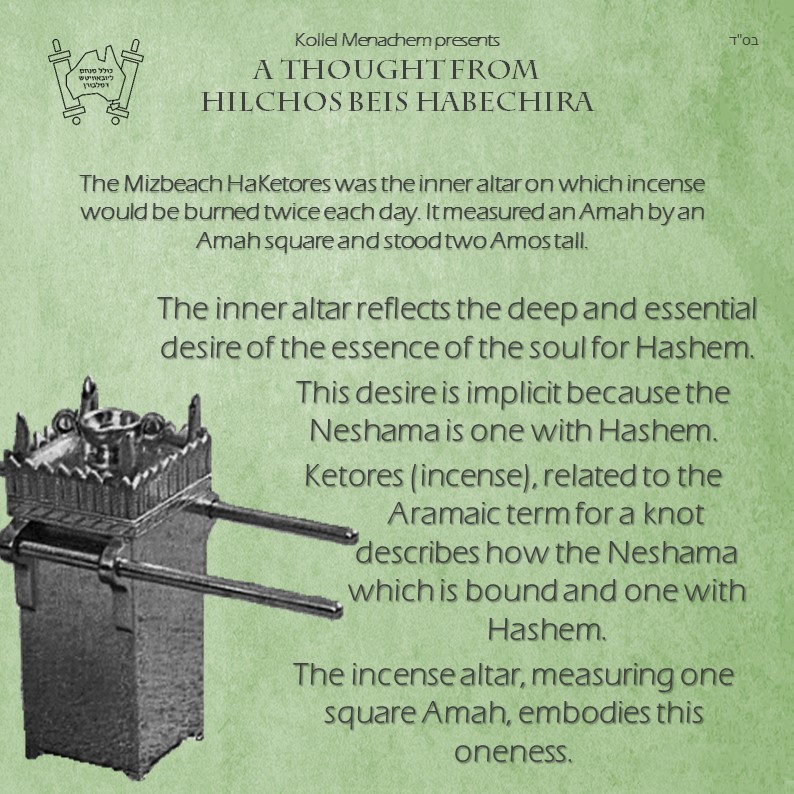|
All of the walls surrounding Har Habayis were built very tall with the exception of the wall above the gate on the Eastern wall which was built lower than the others. Why?
A person who became impure through contact with the dead could only be purified with the ashes of the Parah Adumah. The Parah Adumah was slaughtered and burned on Har Hazeisim to the East of the Beis Hamikdash. Even though the Parah Adumah had to be slaughtered and burned outside of Yerushalaim on Har Hazeisim, the Kohen had to face and be able to see the doorway of the Heichal. The Eastern wall was built lower to give the Kohen an unobscured view all the way into the Kodesh. Spiritual death is disconnection from Hashem – the source of life. The Kohen leaving the Beis Hamikdash to prepare the Parah Adumah represents the sacrifice of leaving one’s own spiritual comforts to bring purity to those who need it. When a person leaves their environment of holiness for the purpose of connecting others to Hashem, it may seem that they are moving away. In truth, Hashem lowers all of the walls and barriers, giving us unhindered access to the deepest levels of connection. Sources: Middos 2:4 Rambam Hilchos Beis Habechira 6:5 The Mizbeach had a base (Yesod) that protruded one Amah outwards. The base only ran along the North and West sides of the Mizbeach. Along the South and East sides of the Mizbeach there was no base. Why?
The Beis Hamikdash structure and the Mizbeach were built in the territory of the Tribe of Binyomin. In Yaakov’s blessings, Binyomin is described as a devouring wolf. Prophetically this refers to the Mizbeach which would consume the Korbanos like a wolf devours its prey. The border with the Tribe of Yehudah ran through the courtyard where the Mizbeach stood. Our sages teach that Binyomin foresaw that a strip of the territory of Yehudah would encroach on the site of the Mizbeach at its South-Eastern corner. Binyomin was deeply bothered by this and yearned constantly for the entire Mizbeach to be within his territory. As a reward for his deep spiritual desire, Binyomin merited to become the resting place of the Shechina in the Beis Hamikdash. The Yesod was not built on this strip of land so that the entire Mizbeach would be in his territory as he had wished. When we have a genuine spiritual desire for connection with Hashem and are bothered when it is lacking in our lives, if we strive and pray for it, Hashem will gift us the spiritual connection that we long for. Sources: Mishna Middos 3:1 Zevachim 53b Zohar Vayechi Unlike the other Keilim, the Kiyor was not used in the Avodah. It was used as a preparation for the Avodah and was the first Keli to be used each day. If a Kohen did not wash their hands and feet before the Avodah, their service would be invalid. The Beis Hamikdash comprises 3 main areas; the Azarah (courtyard), the Kodesh and the Kodesh Hakodashim. These areas and the Avodah performed within them, represent 3 phases in lifting ourselves up to connect to Hashem. The first step when leaving the street to enter the “Beis Hamikdash” of spiritual growth, is the Azarah. The Azarah, like a courtyard, is a preparation before entering into Kodesh and ultimately the Kodesh Hakodoshim. The Kiyor stood in the Azarah. Before entering our homes, we wipe our feet at the door so that we don’t dirty the floor with mud that has been brought in from the street. Without a doormat, the most beautiful home will quickly become spoiled. When a person leaves the outside world and seeks spiritual growth, the first thing that they need to do is to wash off any ‘dirt’ from the outside which may have stuck onto them. These include worldly attitudes and influences which are contrary to Kedusha. If not removed, they will hold us back from real spiritual growth. Then we can engage in our Avodah with the Keilim of Torah and Tefillah, climbing the rungs of holiness in absolute purity. ****************************** Based on Reshimas Hamenora written by the Lubavitcher Rebbe The Menorah was made with decorative features in the shapes of cups, balls and flowers. At the top of each of the seven branches were three of the cup-shaped decorations. The Rambam draws the cups facing downwards.
The seven branches of the Menorah reflect the seven emotional drives of the soul which parallel the G-dly energies of the seven Sefiros. Our emotional drives come from the heart. The three cups at the top of each branch represent the three intellectual processes through which ideas are conceived, developed and internalised. These are the intellectual powers of Chochma, Binah and Daas which rest within the brain. The cups facing downwards, illustrate how the three aspects of intellect pour their flow into each of the branches that make up our emotional experience. Chassidus teaches that the human gift is that our mind rules over our heart, intellect over instinct. Our emotions should be mindful, directed by understanding and appreciation. At the same time, our rational understandings should not remain abstract theory. When we learn about Hashem, we fill our minds with G-dly concepts. We have to channel these thoughts into a meaningful emotional relationship with Hashem. 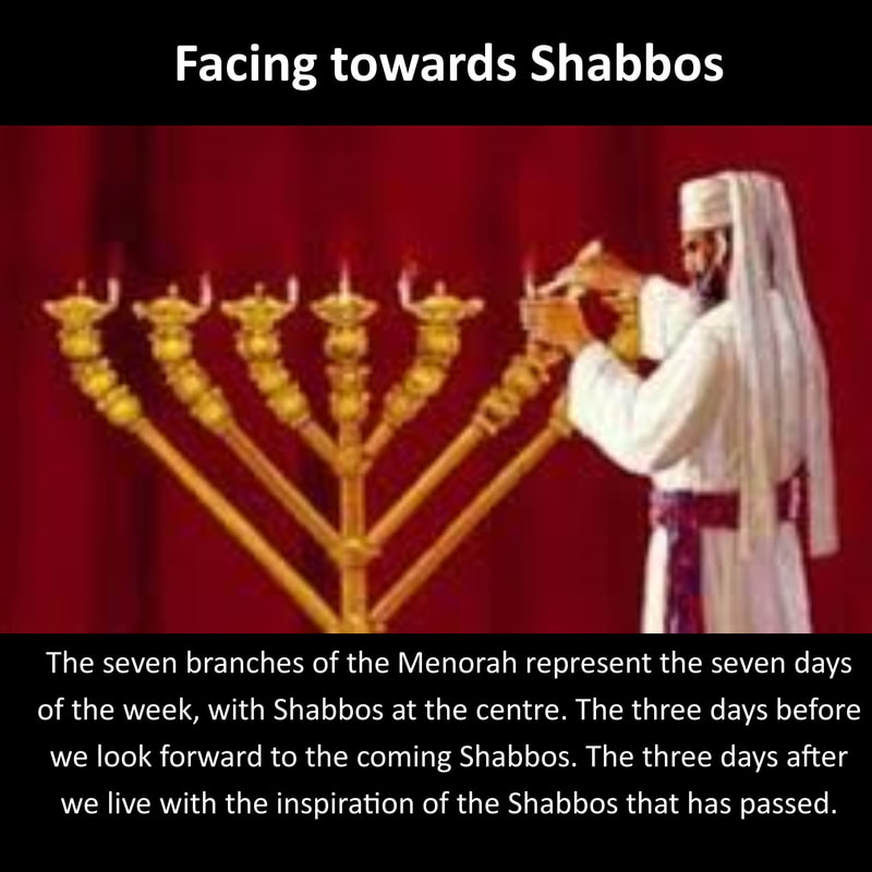 The Menorah had seven branches. The central branch was the body of the Menorah itself. Three branches extended out from each side of the Menorah for a total of seven.
At the top of each branch was an oil cup. The cups were positioned so that the spouts for the wicks all pointed towards the middle lamp. This way all of the flames faced the central branch. Chassidus explains that the seven lights of the Menorah represent the seven days of the week. The central branch and focal point is Shabbos. The six weekdays represented by the six outer branches, all look towards Shabbos. The three days leading up to Shabbos; Wednesday, Thursday and Friday, are referred to as the “days before Shabbos”. We live with the excitement and anticipation, making our spiritual and physical preparations for the Shabbos that is approaching, Sunday, Monday and Tuesday are described as the “days after Shabbos”. We live with the upliftment and inspiration of the past Shabbos. The middle flame is called the Ner Maaravi, the Western Lamp which miraculously burned longer than the others, testifying that Hashem’s presence rests amongst the Jewish people. Shabbos too is an eternal sign between Hashem and the Jewish people. Wishing you a gut Shabbos. On top of the Kapores, the cover of the Aron, stood two golden Keruvim. The Keruvim depicted the love between Hashem and the Jewish people.
According to the Zohar, one of the Keruvim was in the form of a man and the other was in the form of a woman. When the Jewish people would visit the Beis Hamikdash for the Festivals, they would open the curtain of the Kodesh Hakodashim and show the Jewish people the Keruvim embracing one another. They would say “see how you are beloved to Hashem, like a woman is beloved to a man”. The love between husband and wife represents passionate desire. According to the Gemara both Keruvim had the face of a man; one had the face of an adult and the other the face of a young child. This depicts Hashem’s love for the Jewish people using the analogy of a father and his son. A parent’s love for their child is not based on their qualities and achievements. It is not based on what the child does and how they behave. The love of a parent to their child is an essential love because the child is a part of themselves, because it is their child. This is true for every child, but the younger the child, the more apparent it is. A newborn baby has no achievements to boast and yet we love them deeply. At the deepest level of our relationship, the experience of the Kodesh Hakodashim, Hashem’s love for every Jew runs deeper than our observance of the Mitzvos. Every Neshama is part of Hashem Above. He loves us because we are part of Him. One of the names used to describe the Kodesh Hakodashim, the holiest space within the Beis Hamikdash, is the Cheder Hamitos – literally the bedroom.
In their home, husband and wife interact in different rooms and settings. But in their bedroom they express and experience their exclusive bond in the most powerful way. There are no others and nothing outside of the relationship present. Here they are and truly one. The purpose of the Beis Hamikdash is for Hashem’s presence to rest amongst the Jewish people, ושכנתי בתוכם. The relationship of Hashem and the Jewish people is likened to that of husband and wife. We connect to Hashem and He unites with us through the various Temple services performed in the courtyards and chambers of the Beis Hamikdash. But the deepest union of absolute oneness between Hashem and His bride, is the experience of the Kodesh Hakodashim. Like the Kodesh Hakodashim which lay deep within the Beis Hamikdash, deep inside of us, the essence of our soul, the Kodesh Hakodashim of our Neshama, is one with Hashem. On Yom Kippur, the only day on which this room was accessed, we get to sense this deep oneness. Our Avodah is to draw it down and live with it every day in everything that we do. Another name for the Beis Hamikdash is Beis Zevul. This name is connected to the tribe of Zevulun.
The tribe of Zevulun lived on the coast of Eretz Yisroel. They would sail the sea and engage in trade, leaving the borders and holiness of Eretz Yisroel. And yet, the name Zevulun alludes to the Beis Hamikdash, the holiest site in the world. Chassidus teaches that Hashem created the world because He desired a Dirah Betachtonim. He placed us in a lowly, physical world that seems distant from G-dliness so that we can transform it into a dwelling place for Hashem, where His presence is openly revealed. Like Zevulun we travel outside of the borders of holiness, to go out into the world and engage with it. But it is with purpose, to transform the “outside” into a Beis Zevul, a sanctuary for Hashem. Zevulun would inspire their non-Jewish business clients, bringing them closer to Hashem and an admiration for the Jewish people. Many of them would visit the Beis Hamikdash and ultimately convert to Judaism. A businessman should see themselves as a Shaliach. In their business dealings, they have a unique ability to reach those whom others may not reach and inspire them to come closer to Hashem. Each Korban was brought together with Nesachim of wine. The wine would be poured down one of two holes which were built into the South-Western corner of the Mizbeach. The wine would flow down through the Altar and collect in the Shittin beneath the Temple floor.
Korbanos, like the rising flames of the Altar, are about spiritual elevation. The fire rises upwards, elevating the sacrifice and arousing lofty G-dly energies. But these energies remain beyond, aroused in potential but hidden in the spiritual worlds. Wine, which is drawn from inside of the grape, has the ability to reveal that which is hidden. Our sages teach that when wine enters, secrets emerge. Pouring the Nesachim draws the energies aroused by the Korban downwards, bringing them from their hidden state all the way down into the lowest dimensions of our world. Today, our prayers replace the Korbanos. Our daily davening provide us with an outer-worldly spiritual experience and upliftment. But we need to bring it down to impact the world and help us grow in our daily reality. The Nesachim reminds us that whilst we need the elevation experience, Hashem’s ultimate desire is that we reveal His presence within the physical world and pour down this connection into the lowest and most mundane aspects of our lives. When a person builds a building, the first thing that is usually done is to level the site to be able to build on level ground.
The Beis Hamikdash was built on Har Habayis. A retaining wall was built around the mountain and filled in with earth to create a level surface. But the Beis Hamikdash and its courtyards were not built on the flat surface. Instead it was built rising up the slope of the mountain. As one entered deeper into the Beis Hamikdash complex, they had to climb many stairs. There were 12 stairs from Har Habayis up to the Ezras Nashim. The Ezras Yisroel was another 15 steps higher. Finally, to enter the Sanctuary itself one needed to climb additional 12 stairs to enter the Sanctuary itself. Each section of the Beis Hamikdash had an increased holiness. This is reflected in the restrictions on who could enter each area and when. Building the Beis Hamikdash on the slope of the mountain shows how these spiritual elevations manifest themselves in the physical elevation as well. The ultimate purpose of a Beis Hamikdash is for G-dliness to permeate and impact the physicality of the world. In our homes, it means that our relationship with Hashem is not limited to our spiritual experiences. Holiness should reflect itself in the most mundane, physical aspects of our lives as well. The bottom 6 Amos (3 metres) of the Beis Hamikdash structure was the foundation. It was called the “Otem”, coming from the Hebrew term Atum which means filled up. It was a completely solid base on which the weight of the Beis Hamikdash stood.
The foundation of the building is usually not visible. It does not have the same beauty and decoration as other aspects of a building and it is sometimes completely taken for granted. But it is the most important part of the building. The beautiful structure, with all of its features and decoration, would not be able to stand without the hidden, plain, foundation. When the earth shakes and the winds blow, the stability of the building depends on the strength of the foundation. The deepest level of our Neshama is called Eisan, meaning strength. Like the foundation of a building, the essence of our Neshama lies hidden and we rarely sense it on a day-to-day basis. But it is the source of our strength when our world is shaken by crisis or challenge. The Eisan of our Neshama is our unbreakable bond with Hashem. This is the foundation that carries and supports the beautiful structure of the lives that we build. When we face life’s challenges, we just need to dig deep and uncover the infinite strength and faith that lies inside of us. The Heichal, the actual building of the Beis Hamikdash, stood over 100 Amos (50 metres) tall. The top few Amos of height included a Maakeh – a 3 Amah (1.5 metre) wall to fence off the flat roof. This was to keep the Mitzvah of fencing our roofs to prevent someone from falling off and coming to harm. The Mitzvah applies to the roof of the Holy Temple as it does to the roof of a private home.
The roof, the highest point of a building, represents arrogance and feeling ‘tall’. The Mystics explain that arrogance is the ultimate source of all spiritual deficiencies and can lead a person to spiritual free-fall. Making a fence around the roof alludes to curbing one’s feelings of arrogance and developing an attitude of humility. Like the Maakeh atop our private homes, we certainly need to humble ourselves and avoid arrogance that comes from our personal worldly success, qualities and achievements. The Maakeh on top of the Beis Hamikdash teaches us that we need to take equal care to make sure that even our spiritual accomplishments don’t feed our egos either. While the Jewish people were in exile in Bavel, Hashem instructed the prophet Yechezkel to teach them the details of the design of the Beis Hamikdash. Yechezkel challenged Hashem, “how are they capable of making the Beis Hamikdash while they are in exile? First let them leave their exile and then I will tell them!” Hashem responded “just because My children are in exile should the construction of My home be neglected?”
Exile represents a state of spiritual darkness and distance from Hashem. When we feel disconnected we can feel that we are not capable or worthy of serving Hashem through davening or learning. “How is it possible for me to be involved in making a resting place for Hashem when I am in exile?” But Hashem says - keep building my House although you are not in a great place. When you are feeling low, or far from holiness, you can still connect with Hashem. No iron (Barzel) was used in the construction of the first two Temples. Iron could not even be used as a tool as derived from the verse, “an iron utensil was not heard in the House while it was being built.”
Iron, with its superior strength, represents a powerful and stubborn Kelipah which could not be refined in earlier generations. And so it could not be incorporated into... the Beis Hamikdosh. In a vision, Daniel saw a statue which represented the exiles which the Jewish people would suffer. Edom (Rome), the force which destroyed the Beis Hamikdosh and began this long bitter exile, was depicted as legs of iron. Iron can only be defeated with iron. By accessing the Barzel of Kedusha we can refine and nullify the strong Kelipah of Barzel, the iron of Edom The iron of Kedusha lies in the essence of the Neshama. The Jewish people are called a stiff-necked people. In a positive sense, this refers to our ability to be stubborn in standing unbending and uncompromising in our service Hashem, even when facing the stubborn obstructions from within and without. In the final generation of Golus, we can access the iron of the Etzem Haneshama. Using this powerful force of Kedusha, we will overcome the iron of Edom. The iron legs on which Golus stands will crumble. And when it does, the eternal Beis Hamikdosh Hashelishi will be built using iron – the Barzel of Kedusha. After the destruction of the Beis Hamikodsh, the Chachomim instituted many practises to keep the Beis Hamkidosh and Geulah alive in our hearts and our minds.
One of them is the simple act of washing Netilas Yodayim before eating bread.... This Halocha came about when the Beis Hamikdosh still stood. Before eating Terumah, a Kohen would need to wash their hands so that they would be pure. This requirement was applied to Chulin (non-sacred foods) and was extended to Yisraelim as well as Kohanim. Even now when Kohanim no longer eat Terumah, we are all still required to wash our hands before eating bread. The reason for this is that Chaza”l anticipate that the Beis Hamikdosh will speedily be rebuilt and we will have to be immediately familiar with observing the laws of purity and impurity. The return from Golus Bavel was not a complete Geulah because they did not make a remembrance for Yerushalayim and the Beis Hamikdosh. In the merit of our Zecher LeMikdosh we will merit a Geulah Shleimah (Chasam Sofer). Next time you wash Netilas Yodayim, take a few moments to meditate on how this act is preparing ourselves and the world for the imminent coming of Moshiach and the Beis Hamikdosh Hashlishi. The two Keruvim reflected the relationship between Hashem and the Jewish people. When we were faithful to Hashem, the Keruvim would face one another. But when we were not following in Hashem’s way, the Keruvim would turn their backs on each other.
When the non-Jews entered to destroy the Beis Hamikdosh, they found two Keruvim intertwined in an intimate embrace, like the de...ep love between husband and wife. (Since the Aron had already been hidden, these were other decorative Keruvim and not the Keruvim from the Aron cover). The Temple was being destroyed and the Jewish people sent into exile because of their terrible sins. How could it be that at this time the Keruvim were in the most intimate of positions? There is a halacha which obligates a man to spend intimate time with wife before leaving on a journey. It is a time of heightened love and closeness. Despite the fact that the Jewish people were going into Golus, hidden in the Holy of Holies, Hashem’s deep love for his bride shone deeper than ever. Yes Golus is concealment, but it is the beginning of the process of revealing the greatest of lights. We have a tradition that on the day of Tisha B’av, at the moment of the Churban itself, the Neshama of Moshiach was born. This Neshama was conceived through the deep spiritual union embodied in those Keruvim. After conception, hidden inside the womb, the fetus grows and develop, finally emerging to a state of revelation at birth. The conception of Geulah began nearly 2000 years ago in the privacy of the Holy of Holies. Ever since, it has been developing and growing. It is now long overdue and ready to emerge. The holiest chamber of the Beis Hamikdosh was the Kodesh Hakodoshim (Holy of Holies). In the first Temple, the Aron Hakodesh stood in this room on the Even Hashesiya, the foundation stone of the world.
The Aron was hidden towards the end of the first Temple period and was not present in the second Beis Hamikdosh. Yet the Kodesh Hakodoshim remained the holi...est place on earth and only the Kohen Gadol would enter it on the day of Yom Kippur. Unlike the other vessels in the Beis Hamikdosh, the Aron was not used for any Avodah (service). The three areas of the Beis Hamikdosh represent three different dimensions in our personal Avodah and connection to Hashem. The outer courtyard of the Beis Hamikdosh, where the Korbanos were brought, represents our Avodah of refining and elevating our animalistic side. The Kodesh represents our connection to Hashem through the service of the Neshama. The Menorah reflects our Torah and Tefillah. The Shulchan represents Tzedaka and engaging in the world L’shem Shamayim. Both of these areas represent a relationship with Hashem forged by what we do; a service that requires vessels. The Kodesh Hakodoshim expresses a level of relationship which goes beyond and deeper than what we do. At this level, our relationship is not about what we do but rather the very fact that we are. The Kodesh Hakodoshim is the oneness and essential bond from the essence of our Neshama. This bond is not defined or limited by “vessels”. Our sages refer to the Holy of Holies as the Cheder Hamitos (lit. the Bedroom). The bedroom is a sacred space, a place of privacy that reflects the deep union and oneness of husband and wife. The Kodesh Hakodoshim, the level we access on Yom Kippur, is our deepest union and oneness with Hashem. The Aron was a wooden box coated with gold. It was actually made as three boxes; the innermost and outermost were boxes of gold. In between was a box of acacia wood. The exposed tops of the wooden box were then plated with gold.
Like the Aron, our Neshama also has multiple layers. ... Gold cannot decay and will not tarnish. It is pure and will always be beautiful. Wood on the other hand is subject to decay. It can be beautiful and polished but it can also be rotten. The inner core essence of every soul is pure gold. It desires only goodness and connection with Hashem. The middle layer is our psyche of feelings and ideas. Here we have the emotions and understandings of our G-dly soul, but we also have the desires and dark emotions of our animalistic side. We cannot stop ourselves from having these feelings. Like wood, our middle layer can be beautiful but it can also be downright rotten. Our outer layer are our behaviours; our thoughts, our speech and our actions. Tanya teaches that no matter what we may feel on the inside, we have the ability to rule over our negative inner feelings to not give them expression. So while the middle box may be a place of inner turmoil. Our outer box, our behaviours can and should still be like pure gold. Through this, we too become a fitting vessel for Hashem’s presence to rest and be manifest. As part of Hakhel, a wooden Bimah was erected for the king to read the Sefer Torah from. The meforshim explain how it was possible to have a wooden structure when, as discussed previously, no wood could be used or built in the Beis Hamikosh.
Resolutions include that the Bimah stood in the Ezras Noshim where the prohibition did not apply since it had a lesser degree of Kedusha than the actual Azarah. Alternatively, the issur only applies to permanent fixtures. The Hakhel Bimah only stood for a couple of days before being dismantled. In Avodas Hashem we stress the concept of Bittul – humility and surrendering of self. Arrogance is antithetical to serving Hashem and seemingly has no place. A Bimah, which elevates the person, represents a sense of pride, strength and upliftment. These do have an important need in our inner Hakhel; collecting the various dimensions of our lives and personalities to dedicate them to Hashem. Without this strength we would not feel ourselves worthy of drawing close to serve Hashem. We would be intimidated by those who mock and challenge us. This pride ensures that our humility does not allow us to become the proverbial “doormat”. But our Bimah must be of wood, something temporary and not-lasting. We use it only in the holy areas and only as required. We should not let confidence become over-confidence or allow pride to become an internalised, permanent sense of arrogance or brazenness. The Beis Hamikdosh had to be constructed entirely of stones, bricks or cement. Exposed wood could not be used. This is in contrast to the Mishkan, whose primary structure (the walls) was made of wood.
Everything in creation is classified in one of four orders; inanimate (mineral), plant, animal and mankind. Mankind is the pinnacle of creation. The inanimate, which has no life in it, is the lowest of the four orders. This is the reality within the paradigm of creation and world order. But in their spiritual origin the inanimate, which appears to be the lowest, derives from the deepest source. The Mishkan was a temporary dwelling place of the Shechina and reflected the paradigm of creation. And so the plant and animal material were primary. The inanimate was relegated to the floor. In the Beis Hamikdosh the essential truth of reality was revealed, the way things exits in the source. This is similar to the experience in the Messianic era. And so, the Beis Hamikdosh was constructed of stone (the inanimate). The four orders exist within the levels of our soul. Our emotions are like plants that grow and are dynamic. The inanimate are our actions which seem simplistic compared to the vitality of feeling and understanding. Action may seem like the lowest of our expressions, but its source is the loftiest and it is of most consequence. This is the power of the act of a Mitzvah, which achieves more than any meditation can. The Menora would be lit each afternoon as part of the daily Avodah. All seven flames would be lit each night, but they were not all lit at once. The Kohen would first light five of the wicks. The Ketores would then be offered before the final two flames were lit.
What is the deeper lesson we learn from offering the incense in the middle of lighting the Menorah? The Ketores represents the essence of the soul and its desire for and oneness with Hashem. With this desire, the Neshama seeks to transcend the world and cleave to Hashem. The Menorah reflects the conscious levels of the soul, the כוחות פנימיים, which are very much within the world. The seven branches represent the seven Sefiros or Middos, the emotions of the soul. These emotions are divided into two groups; the first five Middos are the primary emotions of the Neshama for its own Avodah. The final two, Yesod and Malchus refer to the soul’s ability to interact with and influence the world around it. The ultimate objective is that the experience of oneness (the Ketores) not remain detached from the world and isolated in moments of spiritual upliftment. We need to permeate our conscious day-to-day living (the Menorah) with the absolute awareness, connection and surrender to Hashem of the soul’s essence; not only in the holy activities of our lives (the five Middos) but also in our day-to-day worldly involvements as well. When burning the Ketores (incense), the Kohen would bring a panful of glowing coals from the outer sacrificial altar. These coals would be placed on the surface of the incense altar. The Ketores would then be sprinkled onto the coals, giving off their fragrance as they burned.
The external sacrificial altar represents the Avodah of refining our animalistic side, like the physical animal which would be elevated through the fires of the altar. We elevate our selfish impulses and behaviours and our material desires through the consuming fires of love of the G-dly soul, aroused by meditation on Hashem’s greatness. Like the wood on the altar, what is left after this rectification are the glowing coals. In a glowing coal, the coarse wood has been consumed by the fire. The fire permeates the coal so that the fire and the coal become one. The incense altar, as discussed previously, represents the essence of the soul and its desire for and oneness with Hashem. This is a far more lofty level than the conscious emotions of the Neshama and its involvement with our animalistic soul. However the coals on which the Ketores was burned on the inner altar had to come from the outer altar. Refining our animalistic side is a prerequisite to attaining the deeper oneness of the Ketores. It is specifically through the Avodah of elevating our animalistic soul that our G-dly soul can then achieve its own elevation. The Mizbeach HaKetores was the inner altar on which incense would be burned twice each day. It measured an Amah by an Amah square and stood two Amos tall.The Midrash teaches that the outer sacrificial altar corresponds to the body. Like the body, this altar would “eat” and “drink” from the sacrifices and wine Nesachim. The inner altar parallels the soul since fragrance, being of a spiritual quality, is something that only the Neshama derives pleasure from.
Chassidus takes this idea deeper. The two altars reflect two dimensions of the soul itself; The outer altar represents the emotions of the conscious soul, referred to as חיצוניות הלב, the external heart. These are the feelings of love for Hashem that are developed through meditation on Hashem’s greatness. The internal heart (פנימיות הלב), represented by the inner altar, is the deep and essential desire of the essence of the soul. This desire is not created or defined (and thus limited) by our understanding. It is an implicit, powerful desire only for Hashem that every Jew possesses, because the Neshama on this level is one with Hashem. Ketores (incense) is related to the Aramaic term for a knot. A knot binds two things together so that they become one. The incense altar, measuring one square Amah, embodies this oneness. The Neshama too is called Achas (one) because it receives from Hashem’s oneness. And the essence of the Neshama, the internal heart, is the Yechida. |
All posts
Read today's Beis Hamikash Thought Archives
July 2023
|
